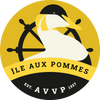THE MAJESTOUS
COMMON EIDER
This magnificent sea duck, little known to the general public because of its rather northern and maritime distribution, far from urban and agricultural centres, is recognized as one of the most beautiful ducks on a global scale and has been the subject of several scientific studies over the years.
A little history
The name eider comes from the Icelandic aedhar and the word "eiderdown" in English, derived from its down, would derive from oedardun. The Common Eider (Somateria mollissima) is found on the coasts of Europe (Netherlands, Scandinavia, Great Britain, Russia), Iceland, Greenland, Eastern America (Massachusetts to the Canadian High Arctic Islands, including the St. Lawrence, Labrador and Hudson Bay), Alaska, Kamchatka and Eastern Siberia and its total population is estimated at over 3 million individuals.
Identification
While the female has a rather dull brown plumage with many dark bars, the male, in the nuptial period, displays a bright black and white livery, a black cap, a green neck and a slightly pink chest. The male's song is then similar to a sound cooing: neck - rouuu.
Attendance
The Common Eider is common in marine areas all year round, feeding exclusively on marine organisms (molluscs and amphipods), and only ventures into the terrestrial environment for the short nesting period (~1 month). Quite gregarious, it often nests in colonies of several hundred or even thousands of individuals, almost always on islands where terrestrial predators are absent.


Nesting
Compared to other duck species, the female eider is the most attentive to its nest, incubating its eggs almost continuously (on average four eggs) during the four weeks of incubation. However, males leave the nesting colony five to seven days after incubation begins, and move to moulting sites.
Nurseries
Females take care of the ducklings alone, taking them to shallow water feeding sites and protecting them from predator attacks. The way in which this maternal surveillance is carried out is particular to the eider duck: impressive groups of several duckling broods, nurseries, are formed under the supervision and protection of mothers and other females.

The colony
The eider duck colony on Île aux Pommes plays an essential role in maintaining the populations of this bird in the St. Lawrence estuary and these eiders do not belong to the island's owners. This environment remains fragile, but intelligent human action, coupled with targeted and decisive partnerships, contributes to the conservation of bird life.
In the service of science
For the last few decades, the island has been an open-air laboratory for the advancement of science. Access to scientists conducting research on avian fauna will remain open. We protect what we know well and this aspect remains a priority. The down eider colony on Île aux Pommes is monitored annually by specialists from Société Duvetnor Ltée. Once a year, biologists conduct an inventory where all nests are located by biologists and systematically counted. The status of each nest, whether it is incubating, hatching, hatching, hatching, abandoned or destroyed by a predator, is also recorded. This inventory makes it possible to accurately monitor the demographic evolution of the eiders that nest on the island.










